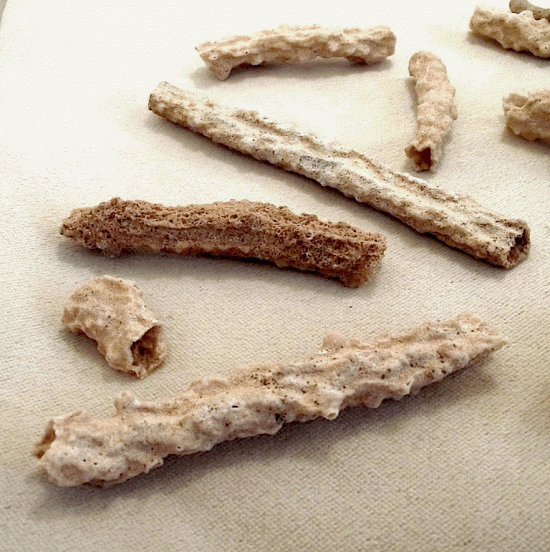
‘Thunderstones’ in the form of fulgurites. Specimens from Algeria, photographed at the San Diego County Fair, California, United States of America (2010). Courtesy: ‘Stickpen’.
August 31, 2012
Leaving no stone unturned, some thunderstones may have acquired their association with lightning in still other ways.
As mentioned in part three of this article, a future realisation that the Australites may actually have precipitated within the past 10,000 years would certainly hit hard.
Yet even this hardly exhausts possibilities. Did some people anciently develop an awareness of the electric properties of some minerals, such as quartz – ‘thunder’ or ‘lightning’ being the closest lexical terms in the vocabulary to ‘electricity’? The equal popularity of quartz crystals and thunderstones among the world’s shamans, often febrile and sensitive to electromagnetic fields, points in this direction. And Pliny did compare ceraunia, the ‘thunderstone’, to rock crystal.
Or was the thunderstone, despite all this, at home in the actual phenomenology of lightning? Did sightings of ball lightning provide an impetus? The association is almost tangible in a tradition such as this one from Czechia: ‘The thunder strikes the earth in the shape of a ball; this ball makes one invisible … The thunder is a glowing stone as large as a walnut, placed under the timbers of the roof as a safeguard against lightning’.
And if that does not fly, it may come as a wake-up call that lightning does form solid objects in sand. In Temple’s words: ‘In fact, there really is something which you can find if you inspect the site where a thunderbolt has struck the ground. It is what is called a fulgurite … The best fulgurites are formed when a thunderbolt strikes sand …’ Descriptions of some ‘thunderstones’ are in fact diagnostic of fulgurites; in Zulu lore, the ‘eggs’ of the lightning bird, inyoni yezulu, appear in ‘furrows’ which arguably refer to fulgurites:
‘When coming to lay its eggs, it sweeps down over the earth, and in order to stop its speed it digs up a furrow in the earth. “Where the furrow ends, there its eggs will be found.”‘
A consideration of fulgurites will only ruffle a few feathers at best, however. As they are tubular rather than spherical, fulgurites do not quite match the roundness or triangularity presupposed for a typical thunderstone: ‘The lightning explanation is not too bad a guess, for lightning actually can melt rock where it strikes – but the resulting ‘fulgurites’ … are irregular tube-shaped bodies …’
Yet digging deeper still, even round objects are now known to form in electrical discharges. Stealing some of C. J. Ransom’s thunder, we recall that spherules were created experimentally by unleashing an electrical discharge upon materials as diverse as a piece of iron oxide, carbonates, manganese dioxide, aluminium, magnesium silicate, rutile, perlite, diatomaceous earth, and hematite. The potential implications of this finding leave one thunderstruck: were some thunderstones the genuine article after all? It is a tantalising prospect marred by the fact that no such spherules have as yet been seen to form in the natural world.
In the clear light of day, the plethora of options calls for a multipronged approach, assessing each contending ‘thunderstone’ in its own light. In lapidary terms, was the thunderstone simply any smallish solid object seen to be deposited or exposed amid a bright flash and a booming sound?
Much would be gained if any extant putative thunderstones could be submitted to mineralogical or palaeontological analysis in order to determine whether they qualify perchance as fossils washed out by thunder storms, electrically conductive artefacts, meteorites, impactites, tektites, fulgurites or – dare one say it? – Ransom’s spherules, and whether their formation could have been witnessed by human observers. This only leaves the question who will have the balls to rise to the challenge.
Rens Van Der Sluijs
Books by Rens Van Der Sluijs:
Traditional Cosmology: The Global Mythology of Cosmic Creation and Destruction
Volume One: Preliminaries Formation












